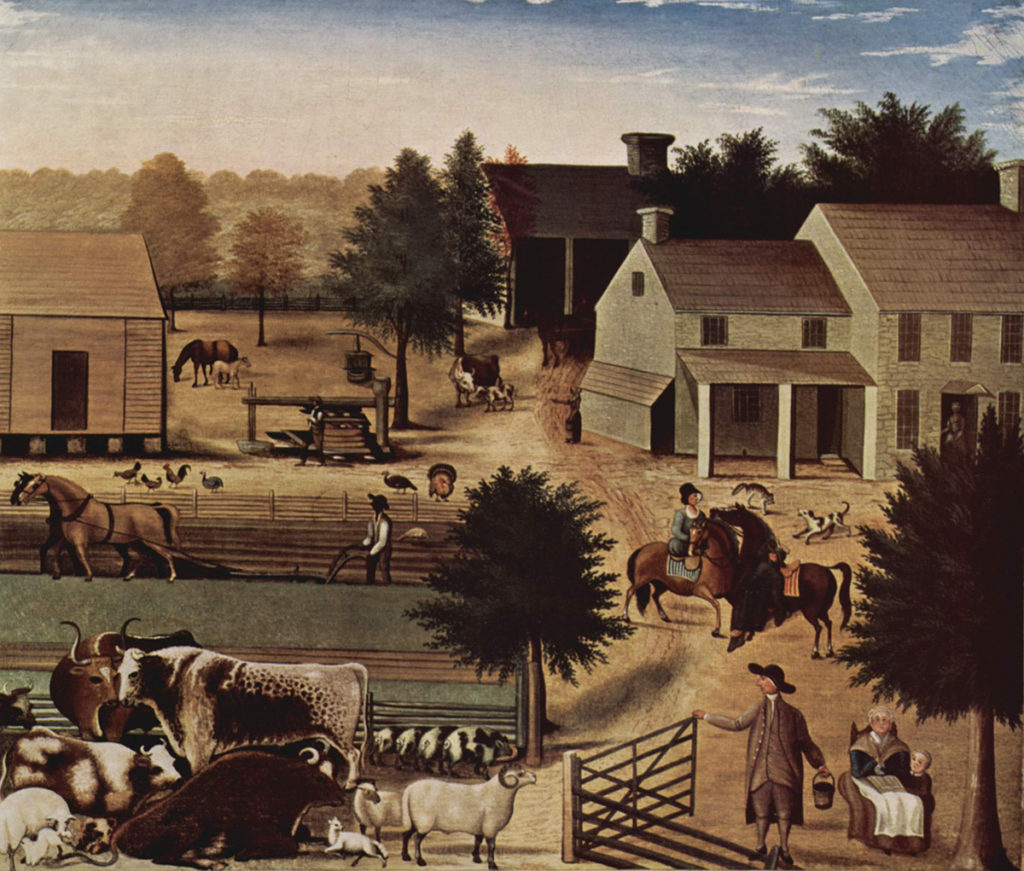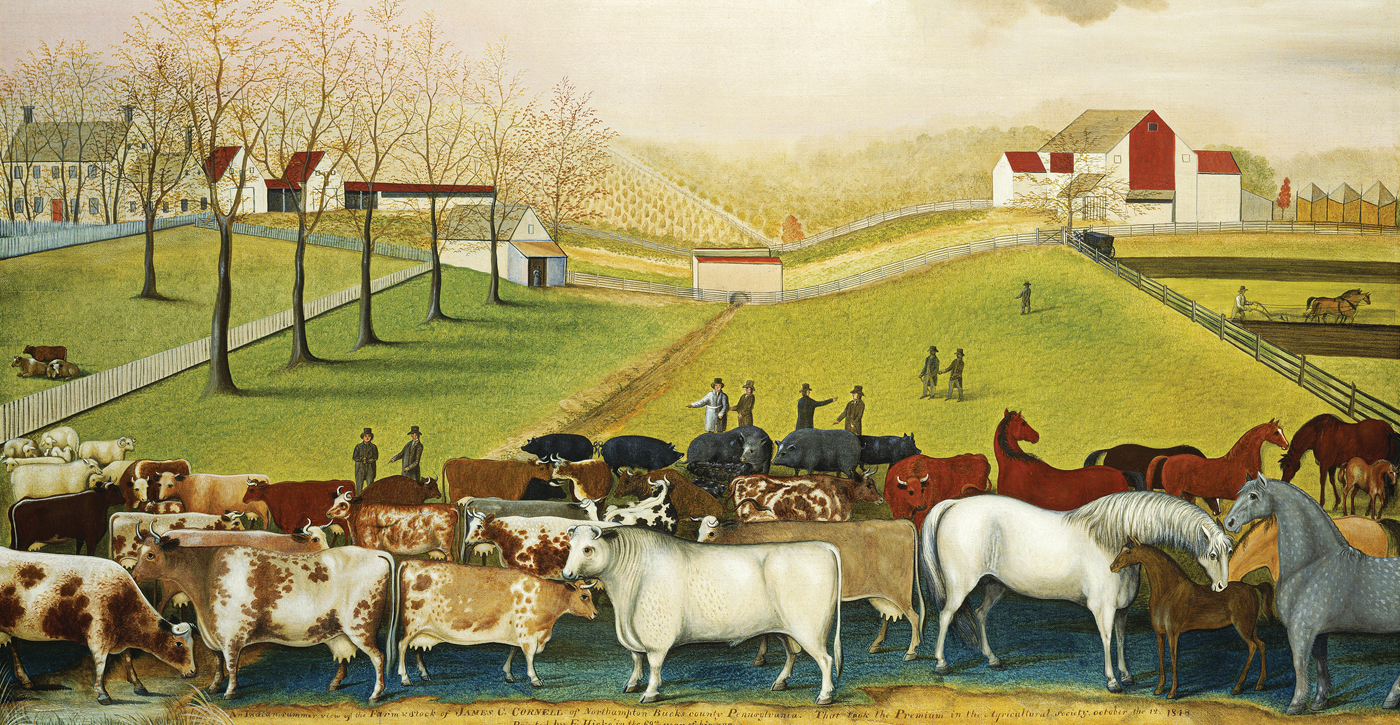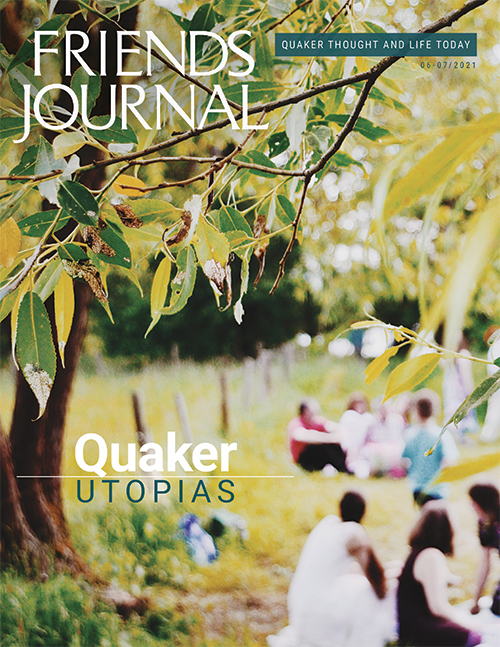Hicksite Friends and the Government of God
Today if one does a Google search for “Oakland, Clinton County, Ohio,” one comes up with a Wikipedia entry that says it was founded in 1806, was named for a grove of oak trees, and that it had a post office from 1839 to 1905. The images are of a frame house and a stretch of Ohio State Route 73. But in the 1840s, the name of Oakland was familiar to radical reformers all over the United States as the home of several families of Hicksite Friends dedicated to women’s rights, absolute pacifism, and the abolition of slavery, as well as being a regular site for reform conventions. The most ambitious of these was held on October 27–28, 1842, to form the Society for Universal Inquiry and Reform. This alliance of Hicksite Friends with other reformers aimed at nothing less than the establishment of a communitarian order that would sweep away coercive government and competitive capitalism and usher in the Government of God on earth.
The roots of Universal Reform lay in one of the most radical reforms to emerge in the United States before the Civil War: nonresistance. In the 1830s, non-Quaker reformers (mainly in New England, and almost all advocates of the immediate abolition of slavery) had, as historian Lewis Perry concluded, come to believe that “slavery, government, and violence were . . . identical in principle.” Slavery was evil because it epitomized unrestrained coercive power, and coercive power, which rested on physical violence, was contrary to Christ’s command that Christians should “resist not evil” and “do good to them that persecute you.” Since all human governments rested on the threat of coercive violence, governments were contrary to God’s will, and consistent Christians should repudiate them, refusing even to vote. Only a few Orthodox Friends showed much interest in nonresistance, regarding it as equivalent to the abolition of all government and thus anarchical. But some Hicksite Friends, most notably Lucretia Mott, became advocates of nonresistant doctrines. (One of the ironies of Mott’s life is that while she was an advocate of women having the right to vote, she was clear that if she had that right, as a nonresistant she would not exercise it.) Nonresistants denied that they were “no government men”; what they wanted was the “Government of God.”
Mankind, the reformers asserted, “should be regarded as an equal brotherhood, the joint proprietors of the soul and of all the products of human industry,” while “the principle which recognizes the right of one man to ownership in the soil and products of industry . . . is the fruitful cause of the evils of civilized society, and the great obstacle to reform.”
Nonresistants differed on how to realize this goal. But by 1842, a small group that combined Hicksite Friends and nonresistant abolitionists with roots in New England Congregational and Baptist churches thought they knew the solution. The Hicksite Friends mainly lived in southwestern Ohio and Indiana. Most notable among them were Abraham Brooke, who lived at Oakland and had recently been arrested for aiding fugitive slaves; Abraham Allen, a well-known conductor on the Underground Railroad; Hiram Mendenhall, who had attracted national attention when on October 1, 1842, he publicly confronted slaveholding U.S. senator and presidential candidate Henry Clay with a petition to free the people who he was enslaving; and Valentine Nicholson, from whose reminiscences we take much of our knowledge. They found allies in John O. Wattles, a traveling nonresistance lecturer from Connecticut; Orson S. Murray, a Vermont Baptist newspaper editor who would soon move to Ohio; and John A. Collins, an agent of the American Anti-Slavery Society. All but Murray were in Oakland in October for an antislavery meeting, so they decided to follow that with the convention that organized the Society for Universal Inquiry and Reform.
After what participants described as an “excited and deeply interesting discussion,” they unanimously adopted a constitution. The preamble was striking. God had provided humanity with laws that, if followed, would “secure ease, peace, Freedom, plenty, and intelligence,” but society, as then organized, produced “toil, anxiety, disease, covetousness, intolerance, poverty, intemperance, slavery, war, and premature death.” The problem was that the human mind was “in its nature progressive, and adapted to truth,” but everywhere it was held back by “sects, parties, governments, creeds, and authorities,” which were by their nature “enemies to human progress and human happiness.” Mankind, the reformers asserted, “should be regarded as an equal brotherhood, the joint proprietors of the soul and of all the products of human industry,” while “the principle which recognizes the right of one man to ownership in the soil and products of industry . . . is the fruitful cause of the evils of civilized society, and the great obstacle to reform.” Thus the solution would be to organize “the social system in accordance with the principles of God’s government, by which equality and interests shall be secured to all.”
True to best practices among antebellum reformers, those attending the convention named a host of honorary vice presidents and correspondents. They included Friends like Lucretia Mott and Abby Kelley; the Black luminaries Frederick Douglass and Charles L. Remond; well-known abolitionists like William Lloyd Garrison; and the transcendentalist Amos Bronson Alcott. They paid little attention to the honor they had received, although Douglass and Remond did attend a Universal Reform convention Collins organized in Lynn, Massachusetts, another Quaker center, later in the year. That convention focused on the evils of private property. All attending agreed that “individual ownership of the soil” was wrong, but some argued that trade and commerce were not in themselves evil. All concluded, however, that a communal reorganization of society must be the foundation for solving society’s problems. “A community of interests and labor will alone supersede the necessity of competition,” the convention resolved, “as individuals combined together may resist the aggressions of the present false system of society.” Community was, as one enthusiast wrote, “the embodiment of all good, and the consummation of all Reform.”

Edward Hicks. The Residence of David Twining 1785, painting, 1846. commons.wikimedia.org.
Eight communities would emerge from the work of the Society for Universal Inquiry and Reform: three in Ohio, four in Indiana, and one in New York. Of the eight, five were founded and mostly populated by Hicksite Friends; only two, in northern and western Indiana, had no Quaker residents. One, at Marlborough, Ohio, had actually formed in 1841 but quickly affiliated with the Universal Reformers. The largest and best documented was at Skaneateles in the Finger Lakes region of upstate New York. The two closest to Oakland and the original Quaker promoters of Universal Reform were Prairie Home, near West Liberty, Ohio, and Highland Home, a few miles north near Bellefontaine, Ohio. The largely Quaker communities in Indiana were Union Home, established land owned by Hiram Mendenhall near Winchester, Indiana; and Fraternal Home, near what is now Pennville, Indiana.
We have glimpses of life in these communities from accounts in sympathetic reform journals, from scattered letters and surviving documents, and in the reminiscences of Valentine Nicholson. A visitor to Highland Home in 1844 addressed a series of questions to residents there:
1. Do you make laws? No!
2. Does the majority govern the minority? No!
3. Have you any kind of delegated power? No!
4. Any kind of government? No!
5. Do you express opinions and principles as a body? No!
6. Have you no tests for members? No!
7. Do you assist runaway slaves? Yes!
8. What are the terms of admission? “The land is free to all. Let those who wish, come and work!”
Highland Home’s residents told the visitor that their mission was simple: “To endeavor to practice the Golden Rule of ‘Doing as they would be done by.’”
Many residents of the communities were committed to dietary and health reform. All tobacco and alcoholic beverages were banned: “hell cabbage and hell broth,” one enthusiast labeled them. Almost all were vegetarians: “I cannot look for a pure manifestation in a body filled with the carcasses of dead animals,” one wrote. Emily Gardner, an Indiana Friend who moved to Prairie Home, rejoiced that meat eating was in disfavor there:
I’m tired of living among squealing hogs and squalling chickens and bawling cows and murdered calves and slaughtered lambs and barking dogs and where even the free birds of heaven hardly dare come near while chanting their sweet song.
Some anticipated contemporary veganism, arguing that animal husbandry required more land, labor, and resources than growing fruits and vegetables. A few even repudiated cooking as a waste of time, especially women’s time, and destructive of the good qualities of food.
By 1846, however, all of the communities had collapsed. The story of each was unique, but certain problems were common to all. Paramount were finances, distribution of labor, and the problem of diverse people trying to live in community.
Only three communities were located on donated land. In the others, supporters and residents pooled resources to buy farms; Prairie Home and Union Home carried significant mortgages. And even when the communities incurred no debts, they faced other costs. Buildings had to be erected. Even if communities grew their own food, tools were needed and had to be purchased or repaired. Some residents arrived absolutely destitute, drawn by the communities’ proclamation of a welcome to all, and needed clothing and bedding. While they might eschew capitalism, the communities needed capital and income. In several communities, supporters who had promised to sell their farms and donate the proceeds backed out after having second thoughts. Esther Ann Lukens, a resident at Marlborough, summed up: the experiment failed “through lack of faith in those who had the funds, and lack of funds in those who had the faith.”
Esther Ann Lukens, a resident at Marlborough, summed up: the experiment failed “through lack of faith in those who had the funds, and lack of funds in those who had the faith.”
Even advocates of community conceded that work and labor were sources of contention in all of the communities. Organizing workforces and production, even of simple handicrafts, usually failed. Many communities, denouncing hierarchy, expected members to work only as they felt led. One sympathetic visitor to Prairie Home in 1844 judged that the men there were doing about half of the work that they were capable of performing. Many spent much of the day cutting melons to eat and talking with each other, apparently reveling in the company of like-minded spirits. As Valentine Nicholson later wrote, too many of them “loved to talk more than they did to work.” And while the communities were emphatic in their support of equality for women, women in the communities continued to bear their accustomed burdens of cooking, washing, cleaning, and childcare.
What we know about the residents of the communities suggests that they were diverse. At Union Home, Fraternal Vale, and the three Ohio communities, most of the residents were Hicksite Friends, and at Skaneateles, Hicksite Friends made up a substantial part of the residents. These Hicksites might be radical in their political and theological views, but they were conventional Friends in other ways. George and Margaret Pryor, Friends from Waterloo, New York, who joined the Skaneateles community, fled after a few months in residence, disgusted by “singing, dancing, and card playing.” Quaker mothers perceived evil influences on their children from some of the other residents. Esther Whinery, a Hicksite who married John O. Wattles in something akin to a Quaker ceremony, flatly told her husband that after her experiences at Prairie Home that she would not raise children in a communal setting. And in several of the communities, conflicts broke out over leadership. Hiram Mendenhall thought that his donation of the land for Union Home should give him a veto over its decisions, something other residents resented. And dissenters at Skaneateles accused John A. Collins of trying to be a dictator.
All of the communities had dissolved by the end of 1846. Physical traces of them are few. The big farmhouse remains at the site of the Skaneateles community. When I visited it in the summer of 1990, a small sign on the lawn identified it as “Community Place.” But many of the Universal Reformers continued their interests in radical reform. Most appeared regularly in the antislavery press in the 1850s. Several, including George and Margaret Pryor, were present at the Seneca Falls Convention for women’s rights in July 1848. Universal Reformers were also prominent in the first women’s rights conventions held in Ohio and Indiana. Mary F. Thomas, a Marlborough resident, moved to Indiana, where she became the first licensed woman physician in the state and an editor of The Lily, the first U.S. newspaper edited by and for women. Valentine Nicholson continued to be a committed radical until his death in 1904 at the age of 95. To the end, he denounced the American legal system for favoring property rights over human rights.
Detecting the lasting influence of these communities is difficult. Except perhaps at Skaneateles, local residents, even Friends, have forgotten them. But they continue to serve as examples of some Friends trying to create a more just and equitable world.




The problem with this and any effort to reform humans on this world, is that it doesn’t account for the diverse ways in which we all have been shaped in many ways, by our family, community, education, beliefs, etc. Only on an individual level can there actually be any transformation that can propel that individual to adopt patterns in harmony with all and develop reverence for all Life. I have never met a single person who has truly become wholly Christ filled, let alone a community with that able to express that expectation.
That does not mean it will never be possible. However, community life is very, very demanding, even without these utopian intentions.
Too bad we don’t have detailed information to analyze the causes of each community’s demise. “Differences in division of labor,” is not enough of an explanation for the failure among communities that discard “competitive capitalism.”
So reminiscent of my memories of an intentional community in Athens Ohio in the mid 1970’s. It had a house and farm in Guysville Ohio and maybe a dozen members. They operate a restaurant in Athens called The Ark.. it seems the community failed over arguments of division of labor and control of finances. Even after their most successful events at the restaurant the till came up short. The members who held the mortgage we’re left holding the bag so to speak. If anyone knows Don Wirtshafter, an active proponent of legalizing marijuana in Ohio, he was an active member.